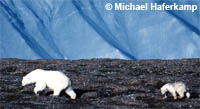Report indicates decreasing biodiversity and increasing number of endangered species
The 'Red List' of threatened species, published by the World Conservation Union (IUCN) had been updated, and now contains 16,119 individual species classified as endangered. Many of the species on the list include highly recognisable animals. Animals familiar to children throughout the world, such as the hippopotamus, polar bear, gazelle and ray all now feature on the list. Worse, 784 species have been declared extinct, while a further 65 species are now only found in captivity. One in three amphibians, one-quarter of the world's coniferous trees, one-quarter of mammals and one-eighth of the world's birds are threatened with extinction. Whether directly, through interference in natural habitat, or indirectly, through climate change, there is a common cause for this increased threat � man. 'The 2006 IUCN Red List shows a clear trend: biodiversity loss is increasing, not slowing down,' according to the IUCN Director General, Achim Steiner. 'The implications of this trend are far-reaching. Reversing this trend is possible, as numerous conservation success stories have proven. To succeed on a global scale, we need alliances across all sectors of society. Biodiversity cannot be saved by environmentalists alone � it must become the responsibility of everyone with the power and the resources to act,' he said. To put into perspective, estimates put the current rate of extinction to be between 100 and 1,000 times the 'background' rate, or the rate of extinction without the interference of man. While the most high profile extinctions occur in the tropics, where human intervention can be brutal, indiscriminate and lasting, such as the logging of Amazonia for roads or pasture, Europe is by no means exempt. The Mediterranean region is a biodiversity 'hotspot' with 25,000 species of plant, 60 per cent of which are unique. An example is the bugloss plant (Anchusa crispa), now only known in 20 sites, with 2,200 mature plants remaining. More encouragingly, conservation efforts in Europe have been successful. Notable examples are the red kite, re-introduced following near extinction in the Welsh borders and the white-tailed eagle, which has seen the category rise from 'Near Threatened' to 'Least Concern' in only a decade. Areas identified as carrying the most risk include delicate habitats, such as very hot and very cold climates. Animals and plants adapted for desert life have been decimated, but silently as many of these species were always rare, but existing in a delicate balance. This balance is breaking. Several species of oryx and gazelle are now approaching extinction. Further north, melting ice-caps have threatened one of the most recognisable animals � the polar bear (Ursus maritimus). If, as projections suggest, summer sea-ice decreases by 50-100 per cent during the next century, then polar bears will decline by more then 30 per cent in the next 45 years. The polar bear is now classed as 'vulnerable'. In the Democratic Republic of Congo, once a haven for the hippopotamus, numbers have declined by 95 per cent. 'Regional conflicts and political instability in some African countries have created hardship for many of the region's inhabitants and the impact on wildlife has been equally devastating,' said the IUCN's chief scientist, Jeffrey McNeely. Local people now hunt the hippopotamus for meat and for its tooth ivory. It's cousin the pygmy hippo fares even worse, victim of extensive illegal logging, it is now classed as 'endangered'. The sea is a new addition to the Red List, with species of sharks and rays studied, and found to be susceptible to over-fishing. European examples include the angel shark and common skate, both once common features in European fish markets, now virtually extinct. In deeper waters, the gulper shark's numbers have dropped by 95 per cent, thanks entirely to fishing. 'Marine species are proving to be just as much at risk of extinction as their land-based counterparts: the desperate situation of many sharks and rays is just the tip of the iceberg,' said the IUCN's Craig Hilton-Taylor, who called for measures to encourage shark and ray numbers, such as non-fishing breeding areas, and catch limits. Freshwater fish have also been found to be at risk throughout the world. In Europe, seven species of carp-like fish have become extinct from Croatia to Turkey. In Africa, the situation is worse, with 28 per cent of freshwater fish threatened. Dragonflies seem to be excellent indicators of the health of environments both above and below the waterline. Dragonfly populations have been found to be in decline in all these areas. There are six specific categories used in the Red List: - Extinct, or Extinct in the Wild, meaning species may exist in captivity; - Critically Endangered, Endangered and Vulnerable � these species are threatened with global extinction; - Near Threatened, species are close to the threatened thresholds and may become threatened without specific conservation measures; - Least Concern, where species have a low risk of extinction; - Data Deficient, where no evaluation has been made due to insufficient data.



